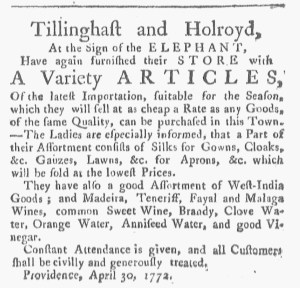What was advertised in a colonial American newspaper 250 years ago today?

“WEST’s ALMANACK for the year 1774.”
For more than a decade, Benjamin West, an astronomer and mathematician, collaborated with the printers of the Providence Gazette in publishing “THE NEW-ENGLAND ALMANACK, OR Lady’s and Gentleman’s DIARY.” In 1773, John Carter worked with West, but other printers previously entered into partnership with him before Carter became the proprietor of the Providence Gazette. Advertisements promoting the New-England Almanack became a familiar sight in that newspaper each fall, continuing into the winter. Some notices provided extensive details about the contents of the new edition for the next year. A shorter advertisement in the December 11 edition of the Providence Gazette promoted “the usual astronomical Calculations,” “a brief historical Account of the Rise and Settlement of RHODE-ISLAND Government,” and “some Anecdotes of the celebrated Mr. ROGER WILLIAMS, Founder of this Colony” in the almanac for 1774.
Carter sold the almanac in “large or small Quantities.” Consumers could purchase individual copies for use in their own households, while merchants and shopkeepers could obtain multiple copies to sell in their own stores and shops. Thurber and Cahoon, for instance, acquired copies to sell in their shop “at the Sign of the Bunch of Grapes.” They stocked a “great Variety of English and India GOODS” imported via “the last Vessel from London” as well as the almanac produced in their own town. To entice prospect customers to visit their shop, Thurber and Cahoon listed many of those items, concluding with “WEST’s ALMANACK for the year 1774.” They had done so the previous year as well. Apparently, Thurber and Cahoon considered the New-England Almanack such a draw that it would help get customers into their shop, though it may have been Carter, rather than the merchants, who decided that the title should appear in capital letters, thus drawing attention to it over the rest of the merchandise in the advertisement. Regardless of who made that decision, Carter and West certainly welcomed the assistance in marketing the almanac beyond their own advertisements.

